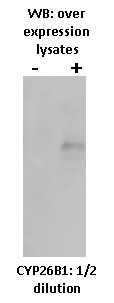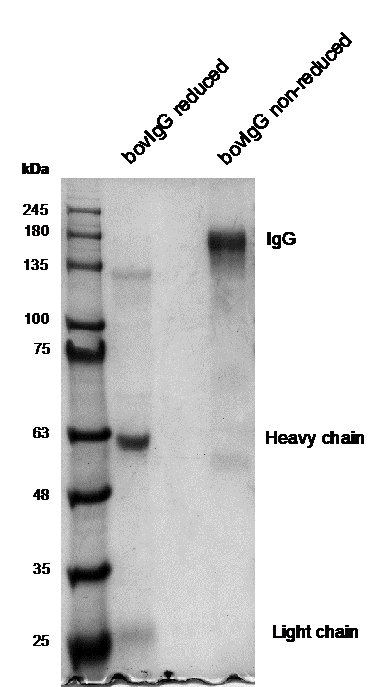Cat. #152120
Anti-Cytochrome P450 26B1 [T5P3G2*A3]
Cat. #: 152120
Sub-type: Primary antibody
Unit size: 100 ug
Availability: 1-2 weeks
Target: Cytochrome P450, family 2, subfamily A, polypeptide 6, CYP26B1
Class: Monoclonal
Application: IHC ; WB
Reactivity: Human ; Mouse ; Rat
Host: Mouse
£300.00
This fee is applicable only for non-profit organisations. If you are a for-profit organisation or a researcher working on commercially-sponsored academic research, you will need to contact our licensing team for a commercial use license.
Contributor
Inventor: Ayham Alnabulsi
Institute: Vertebrate Antibodies Limited
Tool Details
*FOR RESEARCH USE ONLY (for other uses, please contact the licensing team)
- Name: Anti-Cytochrome P450 26B1 [T5P3G2*A3]
- Research fields: Cancer;Cell signaling and signal transduction;Metabolism;Tissue-specific biology
- Clone: T5P3G2*A3
- Tool sub type: Primary antibody
- Class: Monoclonal
- Conjugation: Unconjugated
- Strain: Balb/c
- Reactivity: Human ; Mouse ; Rat
- Host: Mouse
- Application: IHC ; WB
- Description: Involved in the metabolism of retinoic acid (RA), rendering this classical morphogen inactive through oxidation. Involved in the specific inactivation of all-trans-retinoic acid (all-trans-RA), with a preference for the following substrates: all-trans-RA > 9-cis-RA > 13-cis-RA. Generates several hydroxylated forms of RA, including 4-OH-RA, 4-oxo-RA, and 18-OH-RA. Esential for postnatal survival. Plays a central role in germ cell development: acts by degrading RA in the developing testis, preventing STRA8 expression, thereby leading to delay of meiosis. Required for the maintenance of the undifferentiated state of male germ cells during embryonic development in Sertoli cells, inducing arrest in G0 phase of the cell cycle and preventing meiotic entry. Plays a role in skeletal development, both at the level of patterning and in the ossification of bone and the establishment of some synovial joints.
- Immunogen: Ovalbumin-conjugated synthetic peptide DSNQNEILPE (C-terminal sequence)
- Isotype: IgG1 kappa
- Myeloma used: P3X63Ag8.653
- Recommended controls: IHC: formalin-fixed, paraffin-embedded colon carcinoma sections. western blot: overexpression lysates.
Target Details
- Target: Cytochrome P450, family 2, subfamily A, polypeptide 6, CYP26B1
- Tissue cell line specificity: IHC: formalin-fixed, paraffin-embedded colon carcinoma sections. western blot: overexpression lysates.
- Target background: Involved in the metabolism of retinoic acid (RA), rendering this classical morphogen inactive through oxidation. Involved in the specific inactivation of all-trans-retinoic acid (all-trans-RA), with a preference for the following substrates: all-trans-RA > 9-cis-RA > 13-cis-RA. Generates several hydroxylated forms of RA, including 4-OH-RA, 4-oxo-RA, and 18-OH-RA. Esential for postnatal survival. Plays a central role in germ cell development: acts by degrading RA in the developing testis, preventing STRA8 expression, thereby leading to delay of meiosis. Required for the maintenance of the undifferentiated state of male germ cells during embryonic development in Sertoli cells, inducing arrest in G0 phase of the cell cycle and preventing meiotic entry. Plays a role in skeletal development, both at the level of patterning and in the ossification of bone and the establishment of some synovial joints.
Applications
- Application: IHC ; WB
Handling
- Format: Liquid
- Concentration: 1 mg/ml
- Unit size: 100 ug
- Storage buffer: PBS with 0.02% azide
- Storage conditions: -15° C to -25° C
- Shipping conditions: Shipping at 4° C
References
- Brown et al. 2014. PLoS One. 9(3):e90776. PMID: 24608339.
- The expression and prognostic significance of retinoic acid metabolising enzymes in colorectal cancer.




